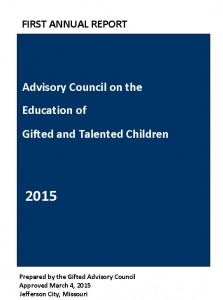Dr. Robin E. Lady, NBCT and President of Gifted Association of Missouri (GAM) announced Gifted Education Week, February 22-26, 2016.
What is “Gifted Education Week” and how does it apply to English language learners? The week will culminate with Gifted Education Day February 24 when 500+ gifted students visit the Missouri state capitol. Teachers, parents, and leaders gather with gifted students to share what they and others are doing for gifted education all year long.
ELLs should not go unnoticed as part of this conversation and exhibition.
Of particular interest is the recently available “First Annual Report: Advisory Council on the Education of Gifted and Talented Children, 2015” prepared by the Gifted Advisory Council:
Of particular interest to ELL educators will be the report’s references to a lack of ethnic, socio-economic or linguistic diversity of students in gifted program services. As well as the Missouri demographic subgroup comparison tables on page 59 of the report which provides two tables comparing demographics of students in Missouri gifted programs over-all to sub populations for 2013-2014. The report reflects that of all MO LEP students, only .14 percent also participate in gifted programming. This is a staggeringly low percentage when compared to a 79.3 percent participation rate of White students in gifted programs, and even when compared to the subgroup category for FRL which shows a 20.2 percent participation rate in MO gifted programs. ELL educators and administrators should be asking why such a discrepancy exists especially in light of research linking multilingualism and creativity. How can identification of ELLs for gifted programming be increased?
You can participate locally and state-wide in the February activities.
Dr. Lady also supplied a PDF suggesting 54 ways students and educators can be involved with Gifted Education Week. 54 Ways to Participate in Gifted Ed Week
Idea number 17 could be a particularly compelling way for ELLs to shine the light on gifted individuals who are also bilingual:
“Study famous gifted people. Select a favorite. Depict that person in a vignette. Share interesting anecdotes with others. Dress up in period costume to be that person for a day.”
(GAM, Gifted Education Week, February 22-26, 2016, Suggested Activities)
If you want more information or to be included in future meetings, you can follow GAM on their website,
facebook page https://www.facebook.com/MissouriGifted/?fref=ts,
and
Twitter: Missouri @GAMgifted
Dr. Robin Lady can be reached at:robin.lady.gam@gmail.com
Phone: 314.203.1165
Gifted programming resources can also be found on the MO DESE website
and by contacting David Welch at:
David.welch@dese.mo.gov
Phone: (573) 751-7754
In doing my part to promote the inclusion of ELLs in Gifted programming, I’m suggesting some of the following research to support your efforts to see that ELLs are included in your district’s pool of gifted students:
Multilingualism and Creativity
by Anatoliy V. Kharkhurin in Bilingual Education and Bilingualism: 88
Includes bibliographical references and index. © 2012 Anatoliy V. Kharkhurin.
“…multilingualism appears as influential but not sufficient requirement for creative endeavors. This conclusion might explain a contradiction between laboratory research and real-life observations: despite a tendency of multilingual individuals to outperform their monolingual counterparts on creativity tests, the former do not necessarily reveal exceptional creative achievements. However, the mere presence of creativity-fostering factors in multilingual development suggests that a combination of foreign language learning with creativity training might provide fruitful outcomes..” (Kharkhurin, p 174)
Additional research on ELLs and gifted education:
Aguirre, N. (2003) ESL students in gifted education. In J.A. Castellano (ed.) Special Populations in Gifted Education: Working with Diverse Gifted Learners (pp. 17–28). Boston, MA: Allyn & Bacon.
Bernal, E.M. (1998) Could gifted English-language learners save gifted and talented programs in the age of reform and inclusion. TAGT Tempo 18(1), 11–14.
Bernal, E.M. (2007) Educating culturally and linguistically diverse gifted and talented students through a dual-language, multicultural curriculum. In G.B.
Esquivel, E.C. Lopez and S.G. Nahari (eds) Handbook of Multicultural School Psychology: An Interdisciplinary Perspective (pp. 479–495). Mahwah, NJ:
Lawrence Erlbaum Associates Publishers.
Granada, J. (2003) Casting a wider net: Linking bilingual and gifted education. In
J.A. Castellano (ed.) Special Populations in Gifted education: Working with Diverse Gifted Learners (pp. 1–16). Boston, MA: Allyn & Bacon.
What steps does your district take to ensure identification and inclusion of ELLs in its gifted programming? I’d love to hear from you.

Awesome article Thanks for sharing.